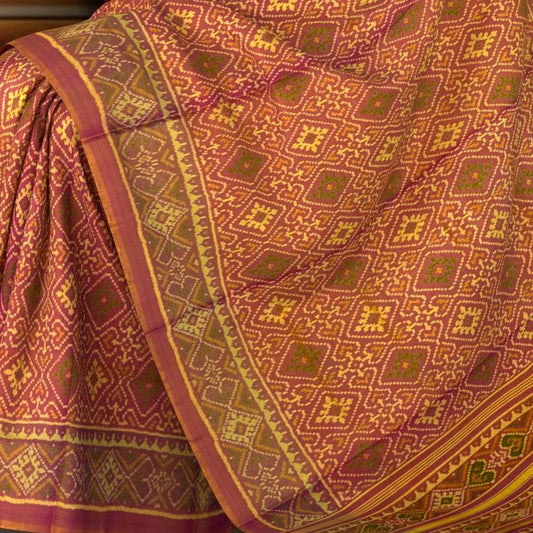Exploring Folklore, Mythology, and Artistic Inspirations of Patola Sarees
Patola sarees, with their intricate designs and vibrant colors, are not just a symbol of traditional Indian craftsmanship; they carry with them a rich tapestry of stories, legends, and cultural significance. Woven meticulously with the double ikat technique, these sarees have been revered for centuries, not only as exquisite garments but also as symbols of status, spirituality, and art. In this blog, we will delve into the fascinating world of Patola sarees as they appear in literature, folklore, and mythology, uncovering the deep-rooted connections these garments have with Indian culture.
The Enigmatic Origins of Patola Sarees
The origin of Patola sarees can be traced back to the ancient city of Patan in Gujarat, India. The art of Patola weaving is believed to have been introduced by the Salvi community of silk weavers who migrated from Maharashtra and Karnataka around the 12th century. These sarees quickly gained popularity among the royal families and aristocrats, becoming symbols of opulence and heritage. The intricate patterns, created through a labor-intensive process of resist dyeing, are a testament to the skill and patience of the artisans who weave them.
Folklore and Mythology: The Tales Woven into Patola Sarees
Patola sarees are more than just textiles; they are embodiments of stories passed down through generations. These sarees have found their place in various folktales and myths, often symbolizing purity, luck, and divine protection.
The Legend of the Divine Weaver
One of the most popular legends associated with Patola sarees is that of the Divine Weaver. According to the myth, a master weaver named Pitambar was chosen by the gods to create a fabric so beautiful that it would be worthy of the divine. Pitambar worked tirelessly, day and night, under the guidance of the goddess Parvati, who herself was said to have woven the first Patola saree. This saree, imbued with divine blessings, was believed to protect its wearer from evil and misfortune. The legend adds a spiritual dimension to the Patola saree, making it not just a garment but a talisman of sorts.
The Tale of the Princess and the Patola
Another well-known story speaks of a princess who was gifted a Patola saree by her father, the king. The saree was so precious that it was only to be worn on special occasions. However, the princess, enchanted by its beauty, wore it every day. One day, a powerful sorcerer, jealous of the king’s wealth, cursed the princess. As the curse took hold, the saree began to unravel, but miraculously, it re-wove itself, symbolizing resilience and the undying spirit of the wearer. This tale is often cited in folklore to illustrate the craftsmanship and enduring nature of Patola sarees.
Patola Sarees in Marriage Rituals
In Gujarat, Patola sarees hold a special place in marriage rituals. A traditional wedding in this region is incomplete without the bride wearing a Patola saree. This custom is rooted in the belief that the saree brings prosperity and happiness to the newlyweds. The intricate patterns of the saree, often featuring motifs of elephants, flowers, and parrots, are not just decorative; they are symbolic of fertility, wealth, and love. The saree is often passed down from mother to daughter, carrying with it the blessings and stories of the family.
The Role of Patola Sarees in Local Folklore and Traditions
Patola sarees have also played a significant role in local traditions and folklore. In many parts of Gujarat, the sarees are considered auspicious and are used in various religious ceremonies. The intricate patterns are believed to have protective qualities, warding off evil spirits and ensuring the well-being of the wearer.
The Dance of the Patola
In some villages, there is a traditional dance performed during festivals where women wear Patola sarees and dance to folk songs that narrate the history and significance of these garments. The dance is a celebration of the artistry and cultural heritage of Patola sarees, and the rhythmic movements of the dancers are said to mimic the meticulous weaving process. This dance is a vibrant display of the saree’s cultural importance and its deep connection to the local community.
Patola in Religious Rituals
Patola sarees are often draped over idols in temples, particularly during festivals and special occasions. The sarees are offered to the deities as a mark of respect and devotion. In some communities, it is believed that offering a Patola saree to a goddess ensures her blessings and protection for the family. This practice underscores the spiritual significance of the saree and its revered status in Indian culture.
Literary References to Patola Sarees
Patola sarees have not only been celebrated in folklore and mythology but have also found their way into Indian literature. From ancient scriptures to contemporary novels, these sarees have been portrayed as symbols of beauty, power, and tradition.
Patola in Ancient Texts
References to Patola sarees can be found in ancient Indian texts such as the Rigveda and the Mahabharata. These texts often describe the sarees as being worn by goddesses and queens, highlighting their association with royalty and divinity. In one verse of the Mahabharata, Draupadi is described as wearing a Patola saree during a significant event, emphasizing the saree’s cultural and spiritual importance.
Patola in Contemporary Literature
In modern literature, Patola sarees have been used to evoke a sense of nostalgia and cultural pride. Authors often describe the sarees in great detail, using them as a metaphor for the rich heritage of Gujarat. In contemporary novels, a Patola saree might be passed down through generations, symbolizing the continuity of tradition and the bond between past and present. The saree becomes a character in its own right, carrying the stories and memories of the women who wore it.
The Artistic Inspirations Behind Patola Sarees
The artistic inspiration for Patola sarees comes from various sources, including nature, religion, and local customs. The patterns and motifs found on these sarees are not just decorative; they are imbued with meaning and significance.
The Symbolism of Patola Patterns
The patterns on Patola sarees often feature motifs such as elephants, parrots, flowers, and geometric shapes. Each of these motifs has its own symbolic meaning. For instance, the elephant symbolizes strength and wisdom, while the parrot represents love and loyalty. The geometric patterns are believed to have protective qualities, guarding the wearer against evil forces. These motifs are not just randomly chosen; they are carefully selected to convey specific messages and blessings.
The Influence of Religion and Spirituality
Religion and spirituality play a significant role in the design of Patola sarees. Many of the patterns are inspired by Hindu mythology and religious symbols. The use of vibrant colors, such as red, green, and yellow, is also significant, as these colors are associated with different aspects of life and spirituality in Hindu culture. Red, for example, symbolizes purity and passion, while green represents fertility and growth.
Conclusion: The Enduring Legacy of Patola Sarees
Patola sarees are more than just garments; they are cultural artifacts that tell the story of a region, its people, and its traditions. From the legends of divine weavers to the vibrant dances that celebrate their beauty, Patola sarees have woven themselves into the fabric of Indian culture. Their presence in literature, art, and folklore underscores their significance as symbols of beauty, power, and spirituality.
As we continue to cherish and preserve the art of Patola weaving, we also preserve the stories, myths, and traditions that are inseparable from these exquisite sarees. The legacy of Patola sarees is one of timeless beauty and cultural pride, a testament to the enduring power of art and tradition in our lives.







Leave a comment
Please note, comments need to be approved before they are published.